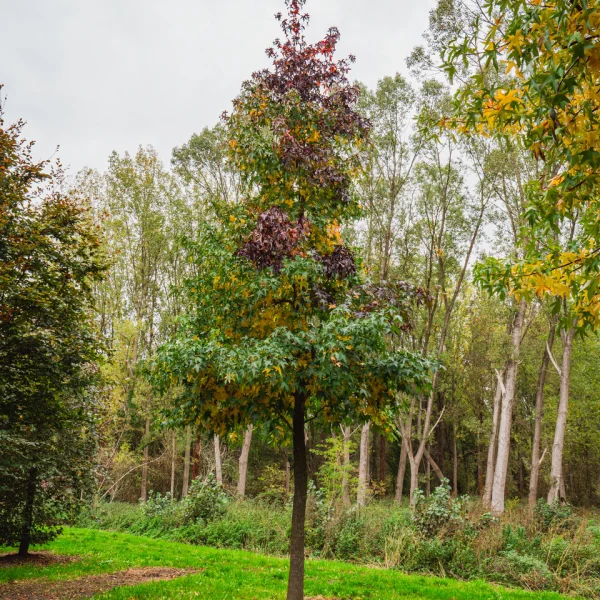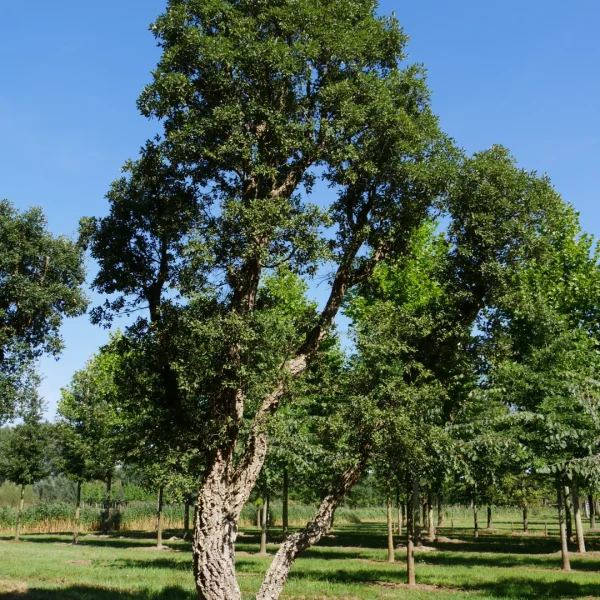Corylus colurna – Turkish hazel, Turkish filbert
Betulaceae
Corylus colurna – Turkish hazel, Turkish filbert
Arbore substanțial, cu trunchiul drept și continuu și coroana larg ovoidală, mai târziu adesea larg conică. Acest trunchi dezvoltă o scoarță aspră și corcodușită la o vârstă fragedă. Ramurile au, de asemenea, o scoarță moale de plută. Frunza este largă și ovoidală inversată, cu o margine dublu zimțată. Este ușor păroasă. Inflorescența este formată din catrințe masculine groase, cu o lungime de până la 12 cm, care atârnă grațios și flori feminine discrete, roșiatice, puțin vizibile. Acestea apar cu mult înainte de înmugurirea frunzelor. Nucile comestibile sunt înconjurate de păstăi de fructe cu formă capricioasă și încrustate în glande și au un diametru de aproximativ 2 cm. C. colurna are un sistem radicular profund. Este un arbore foarte puternic și puțin bolnăvicios, care tolerează bine seceta. De asemenea, tolerează bine pavajul.
Availability
Specifications
Download PDF
Height
20 m
Width
10-12m
Crown
wide ovoid to wide conical, half-open crown
Bark and branches
grey, flaking in small plates
Leaf
wide obovate, dark green, 8 - 12 cm
Flowers
♂ catkins, yellow brown, ± 12 cm, ♀ inconspicuous, February/March
Fruits
edible nuts in capriciously grown husks, edible fruits
Spines/thorns
None
Toxicity
usually not toxic to people, (large) pets and livestock
Soil type
few requirements, preferably calcareous sandy soil
Soil moisture
suitable for dry soil, withstand short flood
Paving
tolerates paving
Winter hardiness zone
5b (-26,0 to -23,4 °C)
Wind resistance
very good
Other resistances
resistant to frost (WH 1 - 6), can withstand wind
Fauna tree
aluable for bees (honey plant)
Application
avenues and broad streets
Shape
clearstem tree, multi-stem treem
Origin
south-east Europe, Asia-Minor
Possibly of interest
Frequently asked questions
Corylus colurna
Corylus colurna can eventually reach a height of 20 m, depending on the site and climate conditions.
Corylus colurna has a average growing and can eventually reach a height of 20 m, depending on the site and climate conditions.
The right time to plant Corylus colurna is during the dormancy period. In Western Europe, Corylus colurna with root balls can generally be planted from mid-November to late April, although this depends strongly on the climatic conditions and the species of tree.
february.
General
 English
English
 English (United Kingdom)
English (United Kingdom)
 Nederlands
Nederlands
 Nederlands (België)
Nederlands (België)
 Deutsch
Deutsch
 français
français
 čeština
čeština
 polski
polski
 español
español
 română
română
 dansk
dansk
 svenska
svenska
 magyar
magyar
 Türkçe
Türkçe
 slovenčina
slovenčina
 русский
русский
 norsk
norsk











